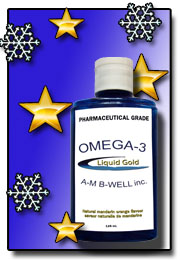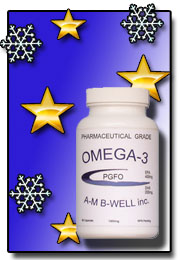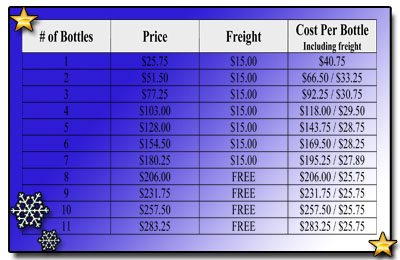

New Years Greetings to all of My Customers, Case Club Members and Friends ...
Hello again my friends!
With a new year comes new resolutions, new challenges and new beginnings.
I have always found it the best time for reflection - on years past - on goals achieved and possibly forgotten - but most importantly - reflecting on the means and measures that can be taken in search of improvement in both one's body and mind for the upcoming year.
My team and I will continue working to help you and your family improve your health and wellness by giving you the tools you need to stay informed and educated on the proven benefits of omega-3 and our fish oil products.
Here is to another year of health, well-being and happiness!
Sincerely,
Anne-Marie
Click here to visit the A-M B-Well Inc. order page and get your PGFO today!!!

Anne-Marie : President and Founder

Why fish stomps flax as a source of omega-3
May 5, 2010
Before we get into talking about the benefits of fish consumption, or how how much fish or fish oil you should eat, it’s probably a good idea to start with a basic review of the omega-3 fatty acids.
Essential Fatty Acids 101
A fatty acid is a chain of carbon, oxygen and hydrogen atoms with a carboxyl group on one end. Fatty acids are classified on the basis of how many carbon atoms are in the chain, as well as how many double bonds exist within the molecule.
Fish contain a variety of fatty acids, but the ones that are believed to confer the majority of the benefits are the long-chain omega-3 fats eicosapentanaenoic acid (EPA) and docosahexaenoic acid (DHA). These omega-3 fats are found exclusively in seafood and marine algae.
As you can see from this chart, it is also possible for the body to synthesize EPA and DHA from the short-chain omega-3 alpha-linolenic acid (ALA). ALA is found in plant foods such as flax, hemp and pumpkin seeds and walnuts.
However, research clearly indicates that the conversion of ALA to EPA and DHA is extremely limited. Less than 5% of ALA gets converted to EPA, and less than 0.5% (one-half of one percent) of ALA is converted to DHA.
A common misconception, especially amongst vegetarians and vegans, is that our need for EPA and DHA can be met by consuming flax oil and other plant sources of ALA. But the conversion numbers above clearly indicate that this isn’t the case.
Studies have shown that ALA supplements (like flax oil) are unable to raise plasma DHA levels in vegans, despite low DHA levels at baseline. (ref) So unless they are supplementing with an algae-derived source of DHA, it is likely that most vegetarians and vegans are deficient.
This is significant because researchers now believe that the majority of the health benefits we get from dietary omega-3 fats come from the longer chain derivatives (especially DHA, as I will explain below).
Is DHA essential?
In fact, some researchers have proposed that DHA is essential. When scientists label a nutrient as “essential”, they they’re not just saying that it’s “very important”. In the context of nutrition essential means that the nutrient cannot be synthesized in the human body, and must be derived from dietary sources.
According to today’s nutrition textbooks, there are only two essential fatty acids, omega-6 linoleic acid (LA) and omega-3 alpha-linolenic acid (ALA). It is believed that as long as these fats are present in the diet, all of the longer-chain omega-3 and omega-6 derivatives can be synthesized in the body.
As I pointed out above, while this is theoretically possible, in reality the conversion doesn’t work well. This is true even for healthy people, but it’s especially true for those with nutrient deficiencies, because the conversion of ALA to DHA depends on zinc, iron and pyridoxine.
The bioavailability of iron in plant sources is poor compared to animal sources, so iron deficiency is common in vegans and vegetarians. This is another reason why they tend to be poor converters of ALA to DHA.
Several other observations support the hypothesis that DHA is essential:
- DHA content in the tissues of all mammals is very similar despite widely varying intakes of omega-3 fatty acids.
- DHA and AA, but not other omega-3 or omega-6 fatty acids, are selectively transferred across the placenta.
- 60% of the dry matter of the brain is lipid, and DHA and AA are the most abundant fatty acids of brain phospholipids.
- DHA status in newborns is much lower in those receiving formula with LA and ALA, than in those receiving milk or formula with pre-formed DHA.
It is possible that the primarily carnivorous diet of our ancestors, which ensured a consistently high dietary intake of DHA and AA, precluded the need to evolve efficient conversion mechanisms.
In other words, since we were eating a lot of meat and fish with pre-formed DHA and AA, our bodies didn’t need to be experts at converting ALA and LA in plants to DHA and AA. It is far easier for the body to assimilate pre-formed DHA and AA than it is to synthesize them from precursors.
What about EPA? Isn’t it essential too?
EPA is another long-chain omega-3 fatty acid that is conventionally believed to be responsible for the benefits of fish consumption.
EPA is often referred to as “anti-inflammatory”. However, according to this report on essential fatty acids by Masterjohn, EPA’s effect seems to be more of an interference with the metabolism of omega-6 arachidonic acid (AA) than the performance of any essential role itself.
Take a look at the chart again that I linked to in the beginning of the post. The fatty acids in blue boxes are less inflammatory, and those in pink boxes are more inflammatory. The chart shows that AA is used to synthesize prostaglandins that cause inflammation (indicated by the pink box on the chart). Because it has the same number of carbon atoms, EPA competes with AA for the enzymes that metabolize it. Since the prostaglandins made by EPA are less inflammatory than those made by AA (indicated by the blue box), EPA is often referred to as “anti-inflammatory”.
But while EPA is certainly less inflammatory than AA, it doesn’t make sense that the body would require an essential fatty acid just to block the inflammatory effects of of another fatty acid.
By contrast, DHA is used to synthesize compounds that play an active role in resolving inflammation. EPA only makes these compounds in the presence of aspirin (PDF). EPA is thus likely to simply be a byproduct of compromised DHA synthesis.
What does this mean to you?
Putting all of this information together yields the following conclusions:
- DHA is the most important of the omega-3 fatty acids, and is primarily responsible for the benefits we get from consuming them.
- DHA is likely to be essential, which means that you must consume it in the diet to prevent disease and ensure optimal function.
- The conversion of plant sources of ALA, such as flax seed oil, to DHA is poor in healthy people and even worse in people deficient in certain nutrients. Vegans and vegetarians are especially prone to be poor converters of ALA to DHA.
- If you’ve been buying flax oil in the hopes that it will help, you’d be far better off putting that money towards some fish or fish oil capsules.
Dietary changes over the past century have lowered the DHA status to a state of subclinical deficiency in many people. Countless studies show that this deficiency is at least in part to blame for the rising incidence of cardiovascular disease, inflammatory disease, mental and psychiatric disorders and suboptimal neurodevelopment.
DHA is not the only reason to eat fish, which is also rich in selenium and vitamin D. However, DHA is likely to be the primary reason why populations that eat fish on a regular basis have consistently been shown to healthier than those that don’t. We’ll discuss this further in the next article.
SOURCE:http://chriskresser.com/why-fish-stomps-flax-as-a-source-of-omega-3
Click here to visit the A-M B-Well Inc. order page and get your PGFO today!!!







5 ml. = 5 capsule
125 ml. / 4 ozs. per bottle
CLICK
HERE
to read label ingredients

90 capsules per bottle
CLICK
HERE
to read label ingredients






A-M B-Well™ Omega-3 PGFO has been third party tested according to the parameters established by the Council for Responsible Nutrition (“CRN”) and the World Health Organization (“WHO”) for its potency and purity by http://www.ifosprogram.com/ and receives a 5 Star rating.
Omega-3 PGFO capsules and Omega-3 Liquid Gold are identical in price, being $25.75 per bottle. Below is a chart listing the prices on the Order Page for Canada and U.S. Retail. The price shows the total price for 1 to 11 bottles with the freight included, then breaks it down by the price per bottle. 8 to 11 bottles are shipped freight-free.
The second chart called Case
Club Membership lists the prices on the Order Page for Canada and U.S.
Wholesale. This chart is to show you how much money you can save per bottle
if you order by the case (12 bottles) and also join the Case Club. You
will further note that the second chart also shows the total price for
bottles for 12, 24 and 36 bottles based on Regular and Case Club prices,
then breaks it down by the price per bottle. As you can see, you are paying
considerably less per bottle by ordering in bulk.







Case
Club membership is $25 per annum.
Club membership gives you a 5% discount on all
your case purchases for one year.
A good idea for customers purchasing 2 or more cases per year.
Visit
our Order Page and choose your Country.
You will be able to choose between Omega-3 PGFO Capsules and Omega-3 Liquid
Gold or order both together.
Warmest Regards,
Anne-Marie

